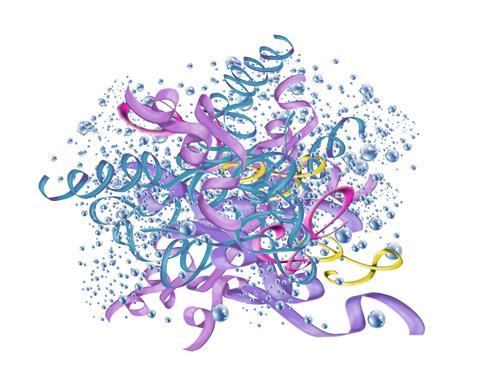How proteins provide a new perspective on the relationship between chemistry and biology
From ensuring I eat enough proteins after training to using polypeptide enriched shampoos, proteins play many undoubtable functions in my daily life. The functionality of proteins also presents an interesting way to think about the relationship between chemistry and biology. One way to separate the two fields is to underline how biology deals with functions for living beings, while chemistry focuses on structure and reactions. Functions are the game of life while structure is the game of chemical molecules.

The matter becomes blurred when one considers disciplines at the border between the two, such as structural biology, molecular biology and biochemistry. With its focus on chemical processes that occur in living organisms, biochemistry in particular can be considered to be based on explaining and predicting the link between the structure of biomolecules and their function.
Proteins are an especially fruitful area of study in this sense. Proteins are chemical macromolecules but are also the result of genetic expression and they have core functions in living beings. My idea is that by looking at proteins, we can see how much structure and function are really two sides of the same coin. Doing so offers us a new perspective on the relationship between chemistry and biology.
On the level
In a simplified overview, proteins present a four-level structure. The linear sequence of amino acids forms the primary structure, with a secondary structure emerging from the stable geometrical patterns localised by hydrogen bonds between the amino hydrogen and carboxyl oxygen atoms in the peptide backbone. Then the polypeptide takes a complex 3D molecular shape, which is called tertiary structure, generally caused by R-group interactions such as hydrogen and ionic bonds, disulphide bridges, and hydrophobic and hydrophilic interactions. Some proteins, such as haemoglobin, present a more complex 3D structure, called quaternary structure, given by the aggregation of folded protein chains.
Given these, where does the functionality of proteins come from? Philosophers are divided on the matter. Some suggest that the source of this functionality is in the chemical properties of the primary structure, as this is the ‘first ingredient’ needed to make proteins. In this account, the tertiary structure of a protein is a consequence of it having the right amino acid sequence. For instance, haemoglobin can fold into its tertiary and quaternary structure because its primary structure allows for the bonds necessary to the folding.
A second option is to apply a biological approach and look for functionality in the evolutionary history of the selected sequences. For instance, the DNA (and then the RNA) sequences encoding the amino acids of haemoglobin have been selected to encode for a protein that has the function of carrying oxygen in blood.
Contemporary research in biochemistry and physiology takes a different direction, focusing on how the core of proteins’ functionality has to be found in the tertiary and the quaternary structure. This is evident in haemoglobin, where changes in the quaternary structure allow the protein to efficiently and responsively load and unload oxygen.
There is no reason to leave functionality outside the domain of chemistry
How can we interpret this link between functionality and structure? My suggestion is that we should see them as two interdependent features. Instead of focusing on primary structure or the evolutionary history only, we can consider tertiary and quaternary structure together with the evolutionarily selected processes to which the proteins contribute. Moreover, the shape (and the folding) of the protein is affected by the cellular, organismal and environmental settings in which the protein developed. These offer the right context to identify which properties of the 3D shape of the proteins are relevant for the given functions.
To illustrate this, consider a couple of examples: haemoglobin and crystallins. The ability of haemoglobin to carry oxygen is directly influenced by its quaternary structure, on which the efficiency of oxygen binding depends. This is further supported by the fact that there is more than one amino acid chain that can compose haemoglobin and fold into the relevant 3D structure without impacting the oxygen-carrying function.
Moreover, locating functionality at the level of the tertiary and quaternary structure is a particularly efficient way to characterise moonlighting proteins such as crystallins. These proteins can perform different functions because different parts of their tertiary structure can bind differently in different environments – for example, aiding sight in eyes and digestion in digestive processes. Functionality results from the interaction between shape and context.
If chemistry is the science of structure and structure matters for functionality, then there is no reason to leave functionality outside the domain of chemistry. On the other hand, if structure is so relevant to functionality, then the integration of structural considerations is needed within biology. Seeing shape and function as two sides of the same coin shows how the borders between biology and chemistry can be blurred. This also explain the success of disciplines, like biochemistry, that are based on such a connection.
Additional information
Francesca Bellazzi is a postdoctoral researcher in philosophy in the ERC Project Assembling Life (101089326) at the University of Oslo, Norway












No comments yet